Scientific name
Goniozus nephantidis (Muesebeck) (=Parasierola nephantidis Muesebeck; Perisierola nephantidis Muesebeck)
Taxonomic position
Hymenoptera: Chrysidoidea: Bethylidae: Bethylinae
Diagnosis
Female: Length 3.4-3.9 mm, forewing 2.2-2.5 mm. Body black, antennae, tibiae and tarsi of legs dark reddish brown or brown, legs lighter brown. Wings clear, stigma and prostigma dark brown, veins dark reddish brown. Antenna (Fig. 1) 13-segmented, inserted close to the apex of head. Eyes with short setae visible at high magnification. Body covered with sparse and short hairs. Head (Fig. 2) with a strong clypeal carina, sides of head behind eyes converging toward rounded posterolateral angles (Fig. 1). Pronotum (Fig. 3) bell-shaped. Propodeum (Fig. 3) with a basal triangular, glossy, smooth area. Abdomen with six exposed segments, last segment conical when viewed from above; sting frequently exserted. Fore wing venation (Figs. 4, 5) as illustrated.
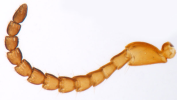 Fig. 1. Antenna Fig. 1. Antenna
 Fig. 2. Head, dorsal view Fig. 2. Head, dorsal view
 Fig. 3. Thorax, dorsal view Fig. 3. Thorax, dorsal view

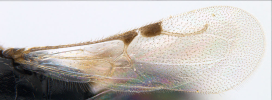 Figs. 4, 5. Fore wing venation Figs. 4, 5. Fore wing venation
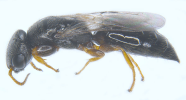 Adult in lateral view
Male: Adult in lateral view
Male: Length 2.5-2.6 mm, forewing 1.7-1.9 mm. Smaller than females, with similar characters.
Images

 Eggs on Corcyra larva Eggs on Corcyra larva
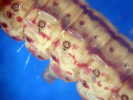
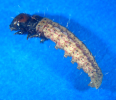 Eggs on Opisina larva Eggs on Opisina larva
 Early instar larvae on O. arenosella Early instar larvae on O. arenosella
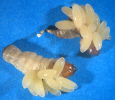
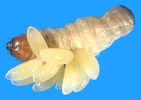 Larvae on Corcyra Larvae on Corcyra
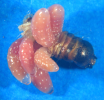 Goniozus larvae on Opisina larva Goniozus larvae on Opisina larva
 Cocoons Cocoons

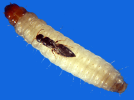 Adult on C. cephalonica Adult on C. cephalonica
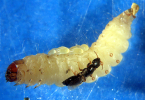 Parental care in adult Parental care in adult
 Adult female, dorsal view Adult female, dorsal view
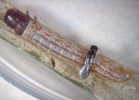 Adult female paralysing O. arenosella larva Adult female paralysing O. arenosella larva
Distribution
India: Widely distributed in Southern states (Andhra Pradesh; Karnataka; Kerala; Tamil Nadu). Sri Lanka.
Hosts
Goniozus nephantidis is a gregarious larval ectoparasitoid of the coconut black-headed caterpillar, Opisina arenosella Walker (=Nephantis serinopa Meyrick) (Lepidoptera: Xylorictidae). It is apparently host-specific, but may have a broader host range. Remadevi et al.
(1996) reported Anigraea albomaculata as an alternate host. Krombein (1996), after examining a paratype from Tamil Nadu, India, bearing the label 'par. on cotton bolls', has also suggested this
possibility.
Biology
Rao & Cherian (1928), Dharmaraju (1963) and several others have discussed the biology in detail. Gordh (1990) lists many additional references to the biology of G. nephantidis in India.
The wasp searches for a larva of Opisina arenosella in the third or fourth instar concealed in the galleries and stings it, paralyzing it permanently. The wasp usually feeds on the fluid contents of the caterpillar before oviposition and occasionally just feeds on the caterpillar without laying eggs on it. A female deposits 1-15 eggs on one or more of the third through the last abdominal segments of the larva.
The eggs are cylindrical and pearly white and measure 0.50-0.75 mm long. They hatch 24-40 hours after oviposition. The larvae are gregarious and feed for 2.5-3.5 days and attain a length of 3.0-4.5 mm before spinning their cocoons in a mass within the galleries of the host larvae. The cocoons are 4.0-6.0 mm long and 1.5-2.0 mm wide and range .in color from white to buff brown. The pupal stage lasts about 5 days, bur the newly emerged adult remains in the cocoon until the integument hardens. Mating occurs about 24 hours after adults emerge from the cocoons. The life cycle from oviposition to adult emergence from the cocoon ranges from 11.5 to 15 days.
Natural enemies
The larvae of G. nephantidis in India are attacked by an unidentified proctotrupoid wasp, two chalcid wasps (a species of Pleurotropis and a species of Eurytoma?), the mite Pyemotes ventricosus (Newport) (recorded as Pediculoides), and an unidentified fungus. The only enemy reported in Sri Lanka is the calliceratid wasp, Calliceras species (Krombein, 1996).
Mass production
The parasitoid is reared in 18.5x8.5 cm specimen jar cages using fully grown caterpillars of O. arenosella or the common laboratory host, Corcyra cephalonica (Stainton) after initial parasitization individually in specimen tubes. The estimated cost of production of 100,000 cocoons of G. nephantidis is Rs. 27600 (Venkatesan et al., 2008).
 Adults in plastic container Adults in plastic container
 Cocoons packed for transport Cocoons packed for transportField release
The adults are released either in the crown region of coconut palms or on the trunk, preferably early in the season before the build up of O. arenosella. Usually, releases of G. nephantidis are recommended as part of the following package: 20.5% of G. nephantidis, 49.4% of Elasmus nephantidis (pre-pupal parasitoid) and 31.9% of Brachymeria nephantidis
(pupal parasitoid). Four releases of G. nephantidis @10/palm are recommended to get good control.
References
- Dharmaraju, E. 1963. Biological control of coconut leaf caterpillar (Nephantis
serinopa Meyrick) in Ceylon. Coconut Research Institute (Ceylon), Bulletin 21, 46 p.
- Gordh, G. 1990. A catalog of the World Bethylidae. Memoirs of the American Entomological Society, 46: 1-364.
- Krombein, K.V. 1996. Biosystematic studies of Ceylonese wasps, XXI: A revision of the Bethylinae and Epyrinae (Cephalonomiini and Sclerodermini) (Hymenoptera: Bethylidae). Smithsonian Contributions to
Zoology, No. 579. Smithsonian Institution Press, Washington, D.C. 29 p.
- Rao, Y.R. & Cherian, M.C. 1928. Notes on the life-history and habits of Parisierola sp.- the Bethylid parasite of Nephantis serinopa. In: Madras Agricultural Department, Year Book 1927, pp. 11-22.
- Singh, S.P. 1995. Technology for Production of Natural Enemies. Technical Bulletin No. 4, Project Directorate of Biological Control, Bangalore-24. 221 p.
- Venkatesan, T., Ballal, C.R. and Rabindra, R.J. 2008. Biological control of coconut black headed caterpillar, Opisina arenosella using Goniozus nephantidis and Cardiastethus exiguus. Technical Bulletin No. 39. Project Directorate of Biological Control, Bangalore 24.
|